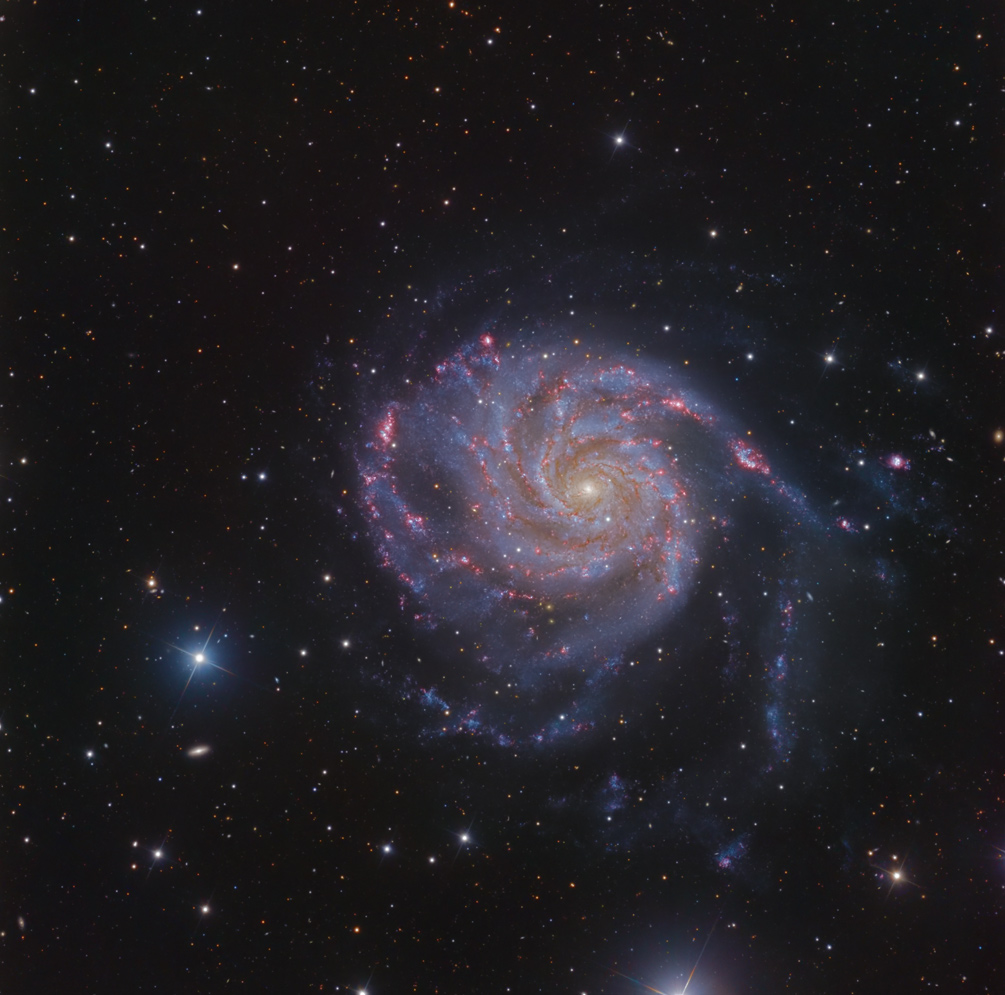M101 is one of the more striking spiral galaxies (like our galaxy, the Milky Way) in the northern sky;
It is a grand design spiral galaxy, with about one trillion stars (twice as many as our Milky Way is thought to have).
It has a diameter of approximately 170,000 light years, making it a relatively large galaxy (our Milky Way now is thought to be of similar size). The field is about the angular size of a full moon.
Its relatively close distance of about 27 million light years allows it to be studied in some detail. It is located in Ursa Major (of which the Big Dipper is a part), near the tip of the handle of the
Big Dipper. Recent evidence indicates that a close gravitational interaction with a neighboring galaxy created waves of high mass and condensed gas which continue to circle the galaxy. These waves
compress existing gas and cause star formation. One result is that M101 has several extremely bright star-forming regions (called HII regions) spread across its spiral arms (which appear as pinkish
blobs in the picture). M101 is so large that its immense gravity distorts smaller nearby galaxies.
As is often the case with large-field deep-sky photographs, there are a lot of tiny (meaning, of course, very far away) galaxies in the background of this photo (including and especially what
appears to be a distant and large galaxy group midway between the left edge of the galaxy and the left edge of the frame).
This is the third time I have imaged this spectacular galaxy. Click here to see the first effort (one of my first images ever, in 2001); click here to see the second (2007).
|
Technical Information:
Ha:L:R:G:B: 450:585:210:225:240 (a total of over 28 hours of light-frame exposure time); luminance, red and green exposures were all 15-minute exposures;
blue all 20-minute exposures; Ha were all 30-minute exposures. The luminance layer consisted of 39 fifteen-minute images through the luminance filter. The red channel is a combination of fourteen 15-minute images thorugh a red filter.
The green channel is a combination of fifteen 15-minute images through the green filter. The blue channel is a combination of twelve 20-minute images through a blue filter.
Equipment: RC Optical Systems 14.5 inch Ritchey-Chretien carbon fiber truss telescope, with ion-milled optics and RCOS field flattener, at about f/9, and an SBIG STX-16803 camera with
internal filter wheel (SBIG filter set), guided by an SBIG AO-X, all riding on a Bisque Paramount ME German Equatorial Mount.
Image Acquisition/Camera Control: Maxim DL, controlled with ACP Expert/Scheduler, working in concert with TheSky X.
Processing: All images calibrated (darks, bias and sky flats), aligned, combined and cropped in Pixinsight. Color combine in Pixinsight. Some finish work (background neutralization,
color calibration, NB blend, deconvolution, multiscale linear transform, HDR multiscale transform, and noise reduction) done in Pixinsight; some cleanup finish work was done in Photoshop CC.
Location: Data acquired remotely from Sierra Remote Observatories, Auberry, California, USA.
Date: Images taken on many nights in May and June of 2022. Image posted July 28, 2022.
Date: Image scale of full-resolution image: 0.56 arcseconds per pixel.
Seeing: Generally good; luminance images varied in FWHM from 1.7 to 2.5 arcseconds.
CCD Chip temperature: -25C

